Annoying noises from commuters, parties, and neighbors can disrupt your peaceful home. Ever thought of using trees to block off or reduce sound?
Here are some of our favorite trees that serve as effective sound barriers. You never know, these can help you maintain quiet surroundings or prevent your festivities from bothering the neighborhood!
Holly
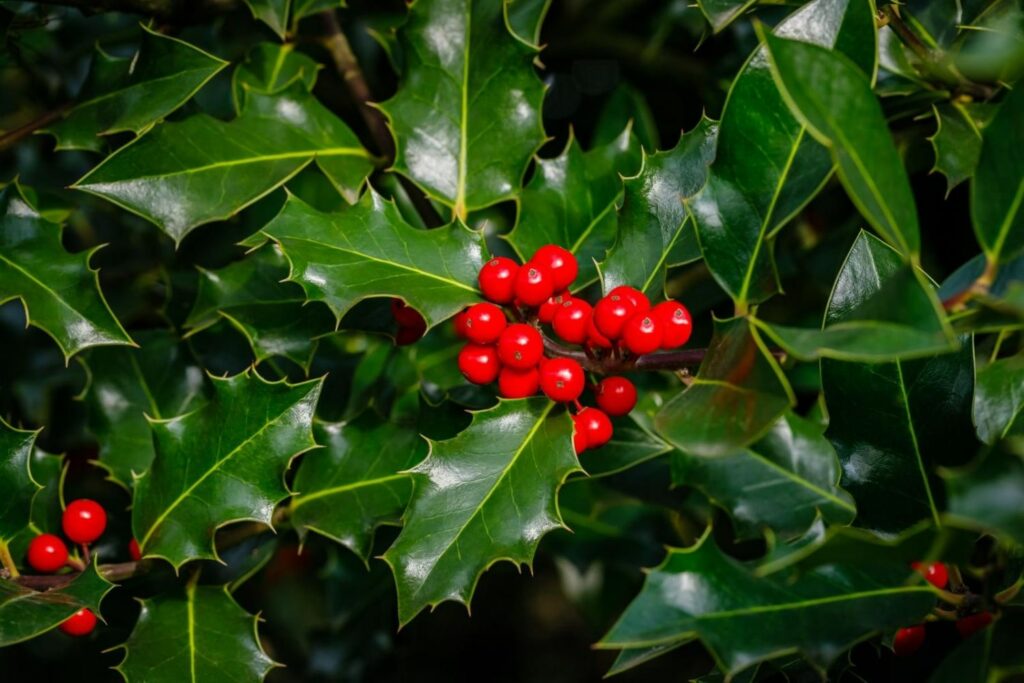
| Characteristic | Description |
| Sound Barrier Effectivenes: | Moderate ●●●○○ |
| Common Name | Holly |
| Scientific Name | Ilex spp. |
| Family | Aquifoliaceae |
| Care Level | Low to moderate. |
Holly plants can be shrubs or trees. They generally have spiny leaves.
They do provide some sound-dampening effects if the noise is not too loud. They aren’t the best for complete silence, but they work as sound barriers.
The plant’s height depends on the species, usually between 3 to 50 feet, with a slow to moderate growth rate.
Pittosporum
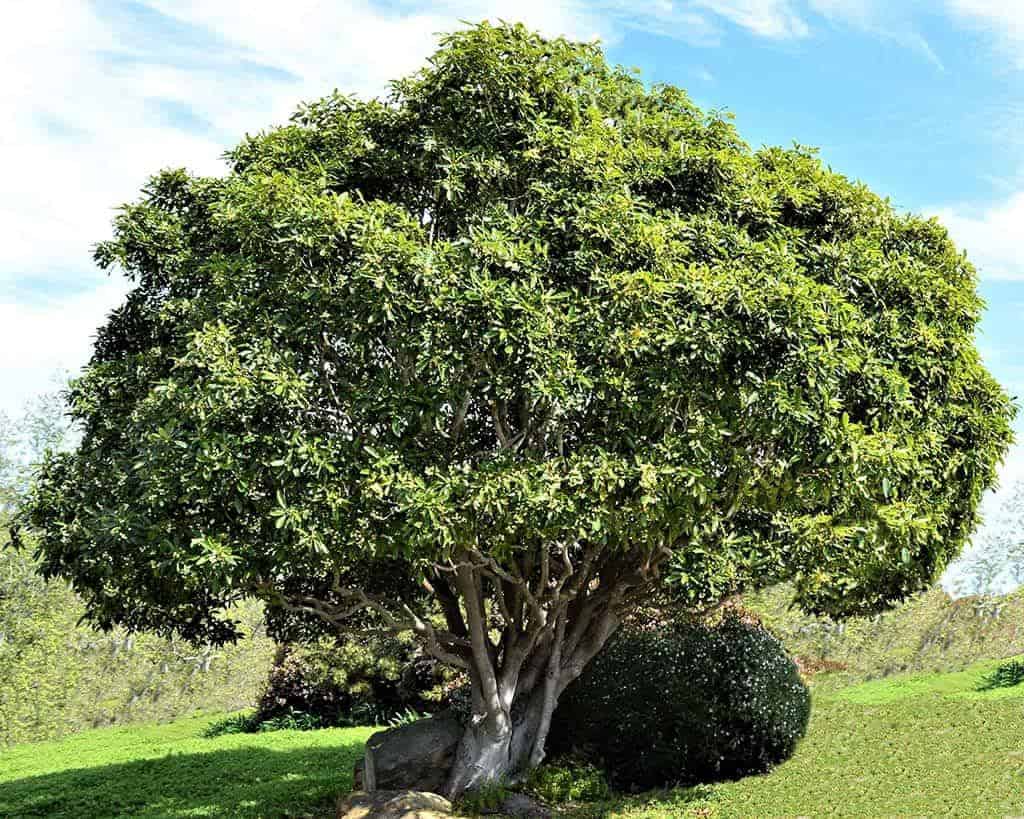
| Characteristic | Description |
| Sound Barrier Effectiveness: | Moderate but can be limited ●●●○○ |
| Common Name: | Pittosporum |
| Scientific Name: | Pittosporum spp. |
| Family: | Pittosporaceae |
| Care Level: | Low to moderate. |
Pittosporum plants can be shrubs or trees. They may reduce noise but are not the best for your total sound barrier.
This plant requires full sun to partial shade for optimal growth. It should be regularly watered, and it can adapt to different soil moisture levels.
This is an evergreen plant with a moderate to fast growth rate, and its average height varies depending on the species, typically ranging from 6 to 30 feet.
Indian Hawthorn
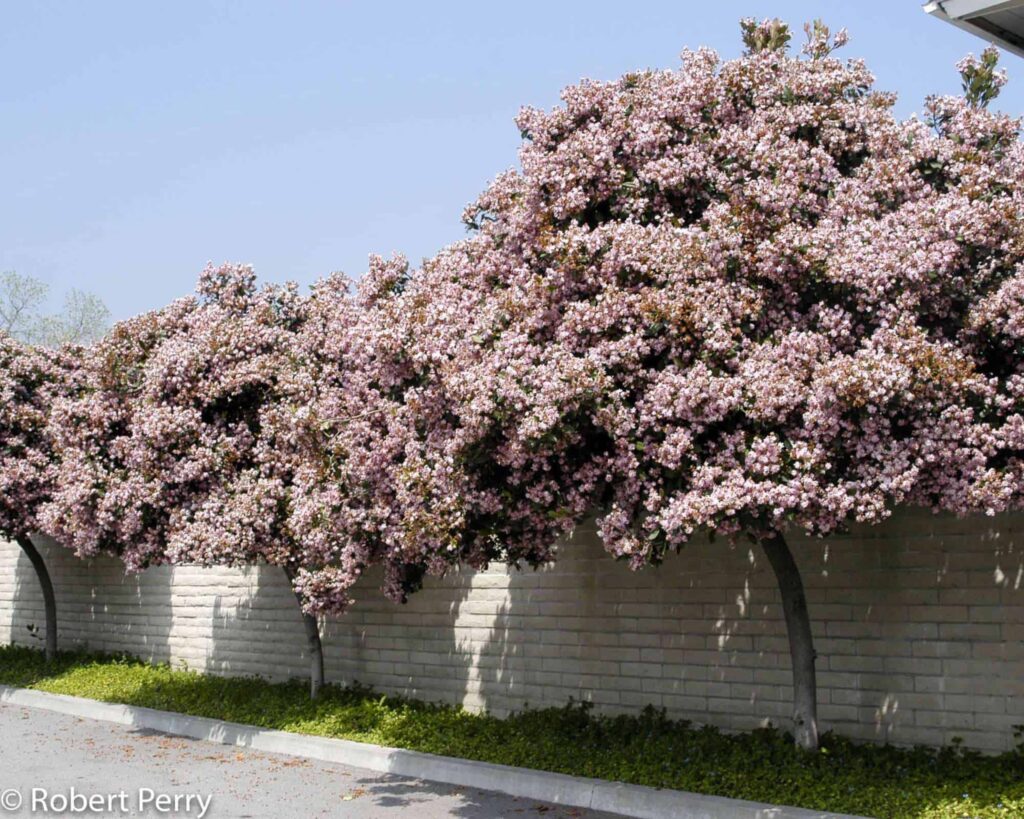
| Characteristic | Description |
| Sound Barrier Effectiveness: | Moderate when planted densely ●●●○○ |
| Common Name: | Indian Hawthorn |
| Scientific Name: | Rhaphiolepis indica. |
| Family: | Rosaceae |
| Care Level: | Low to moderate. |
Indian Hawthorn has small, glossy leaves. Though not ideal for sound barriers, it can reduce noise when planted densely.
It requires full sun to partial shade for optimal growth. The Indian Hawthorn prefers regular watering and well-draining soil with a slight acidity to slightly alkaline pH.
In spring, it benefits from fertilization using a balanced, slow-release fertilizer. As an evergreen shrub, its average height ranges from 3 to 6 feet, although this can vary depending on the cultivar.
Privet
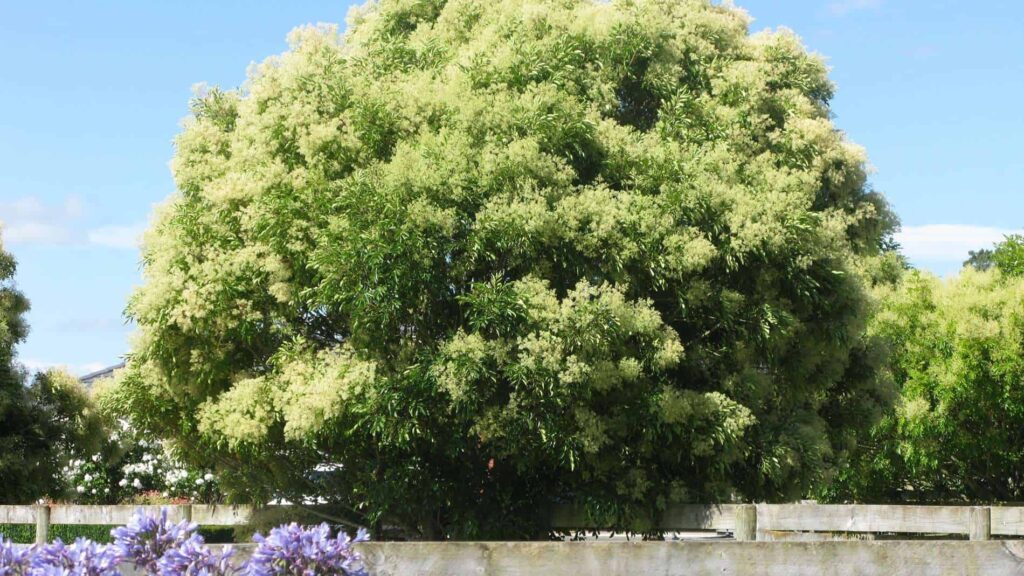
Privet is a hedge shrub, but it’s not the best sound barrier like big trees. It requires full sun to partial shade and prefers well-draining soil.
It also needs regular watering, especially during its growing season. Fertilization is recommended in the spring, using a balanced fertilizer.
This plant can tolerate various soil types but prefers well-draining soil for optimal growth. Its life cycle is deciduous to semi-evergreen, meaning it may shed some leaves in certain seasons.
Bamboo

Bamboo, a fast-growing grass, creates a dense screen when planted close together. Some bamboo types offer moderate sound barrier abilities.
Bamboos need full sun to partial shade for optimal growth. It should be watered regularly, and the soil should be kept consistently moist.
follows a perennial life cycle and can be propagated through division or from culm cuttings. Depending on the species, the average height ranges from a few feet to over 100 feet, and it’s considered a fast-growing plant.
Magnolia
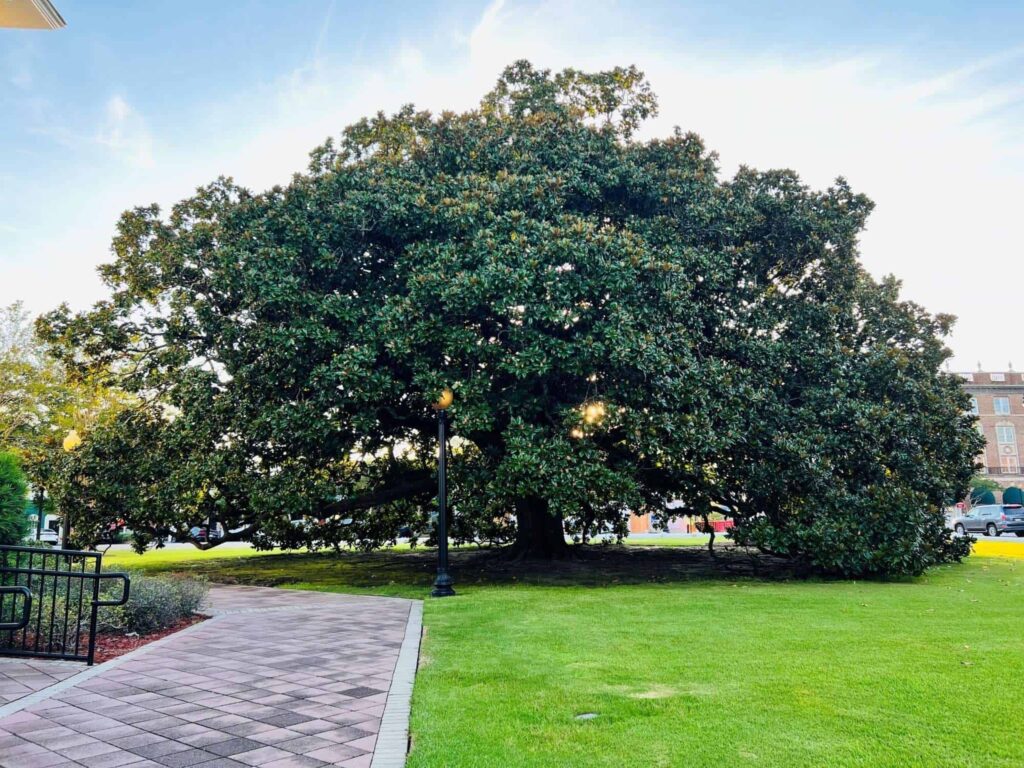
| Characteristic | Description |
| Sound Barrier Effectiveness: | Moderate when planted densely ●●●○○ |
| Common Name: | Magnolia |
| Scientific Name: | Magnolia spp. |
| Family: | Magnoliaceae |
| Care Level: | Moderate to high. |
Magnolias can be shrubs or trees with big, leathery leaves and though they reduce noise, they aren’t the best sound barriers. Magnolias require full sun to partial shade for optimal growth while preferring regular watering and thrive in moist, well-draining soil.
During spring, fertilize with a balanced, slow-release fertilizer to complement well-draining, rich, and slightly acidic soil. it’s deciduous and loses its leaves during winter.
The average height varies depending on the species, ranging from 10 to 80 feet. The plant has a moderate to fast growth rate but some species can be toxic, and contact with the sap may cause skin irritation.
Laurel
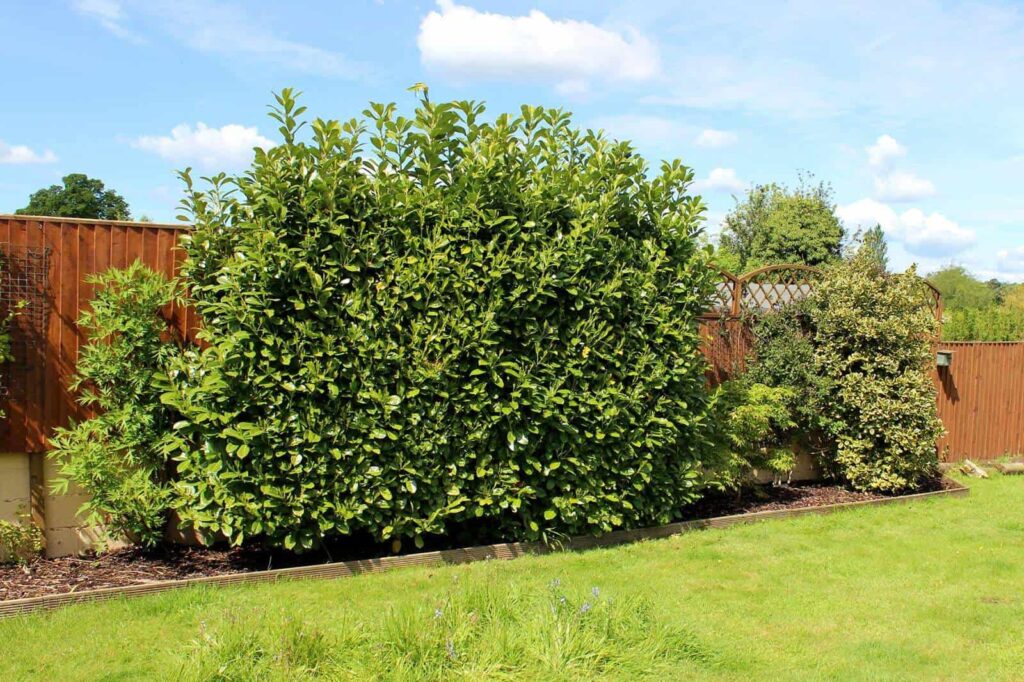
| Characteristic | Description |
| Sound Barrier Effectiveness: | Moderate but can be limited ●●●○○ |
| Common Name: | Laurel |
| Scientific Name: | Various species in the genera Prunus, Laurus, Kalmia, etc. |
| Family: | Rosaceae, Lauraceae, Ericaceae, etc. |
| Care Level: | Low to moderate. |
Laurel plants can be shrubs or trees and, depending on the species, they tend to have broad, glossy leaves that help reduce noise when planted as thick hedges. The laurel tree requires full sun to partial shade, regular watering, and well-draining, fertile soil.
Fertilize it once a year in spring using a balanced slow-release fertilizer as the life cycle can be either evergreen or deciduous, depending on the species. Propagation can be done through seeds, cuttings, or layering.
The average height varies widely depending on the species, and its growth rate is moderate to fast. Keep in mind that some Laurel species can be toxic if ingested by humans or pets.
Juniper
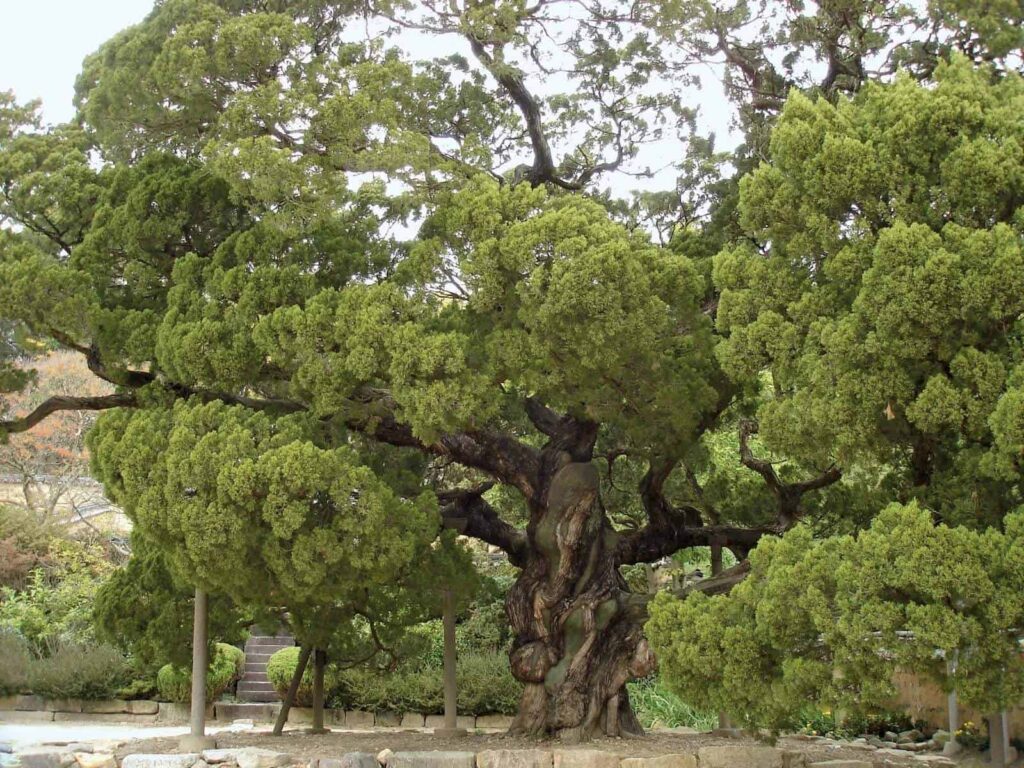
| Characteristic | Description |
| Sound Barrier Effectiveness: | Decent sound barrier capabilities |
| Common Name: | Juniper |
| Scientific Name: | Juniperus spp. |
| Family: | Cupressaceae |
| Care Level: | Low to moderate. |
Junipers are evergreen shrubs or small trees with dense foliage, and these features make them good sound barriers, especially when planted in groups. Junipers need full sun to partial shade and are drought-tolerant once established.
Generally, the juniper tree has low fertilizer needs, so it’s best to avoid excessive nitrogen application. While it thrives in well-draining soil and can tolerate various soil types, it remains green throughout its life cycle as it’s an evergreen plant.
Its average height varies depending on the species, typically ranging from 3 to 30 feet. The plant’s growth rate is slow to moderate.
White Pine
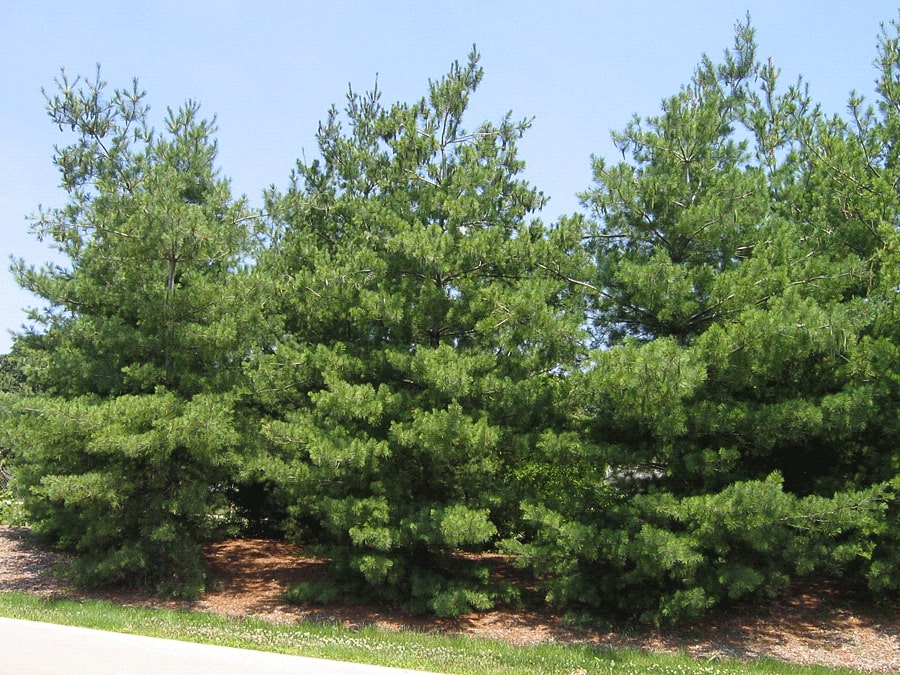
| Characteristic | Description |
| Sound Barrier Effectiveness: | Moderate ●●●○○ |
| Common Name: | White Pine |
| Scientific Name: | Pinus strobus |
| Family: | Pinaceae |
| Care Level: | Low to moderate. |
The White Pine can act as a sound barrier when planted in groups, so arrange them like a line of strong green soldiers and feel the difference! The White Pine requires full sun, well-draining soil, and needs regular watering.
Fertilization is necessary once a year in early spring, using a balanced slow-release fertilizer on well-draining and acidic soil as the plant is evergreen. It tends to grow fast when young but slows down with age.
Be aware that while the plant is generally non-toxic, its pine needles can be irritating to pets if ingested. Before planting any White Pine cultivars, consider local climate and soil conditions and check available space and potential impact on neighboring properties.
Fir
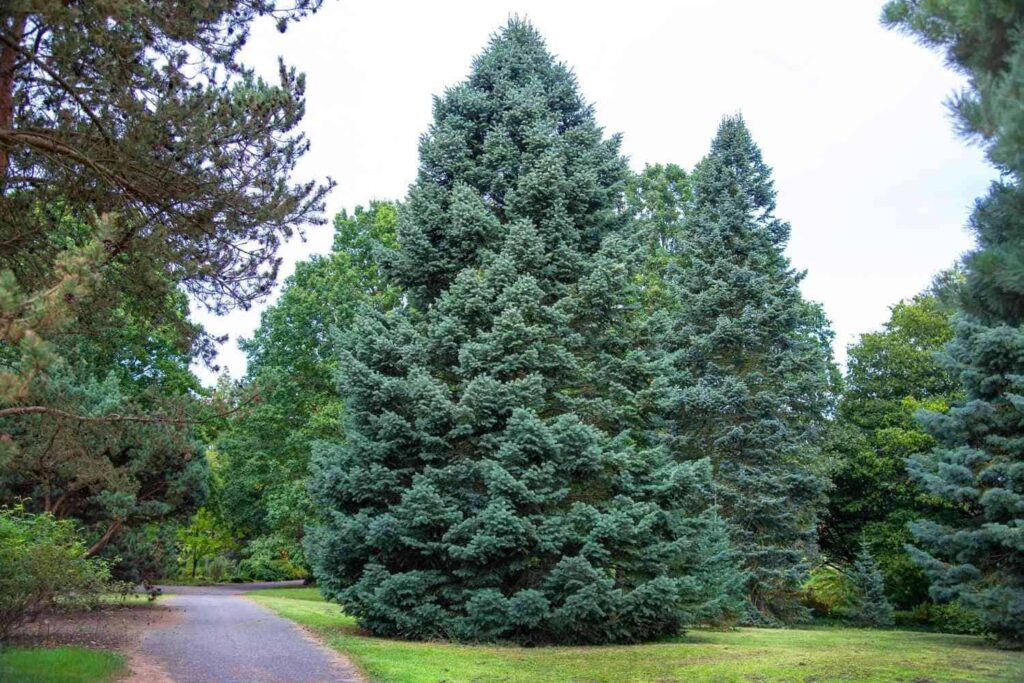
| Characteristic | Description |
| Sound Barrier Effectiveness: | Effective ●●●●○ |
| Common Name: | Fir |
| Scientific Name: | Abies spp. |
| Family: | Pinaceae |
| Care Level: | Moderate to high. |
Fir trees are tall evergreens that are dense and good for sound barriers and they’re even more effective when grouped. The fir tree requires full sun to partial shade and prefers moist, well-draining soil. it’s an evergreen with a slow to moderate growth rate.
Fertilize once a year in early spring using a balanced fertilizer. It’s generally non-toxic, but some species may cause skin irritation.
The average height varies depending on the species and can range from 30 to 250 feet. To propagate, use seeds or softwood cuttings.
Sugi
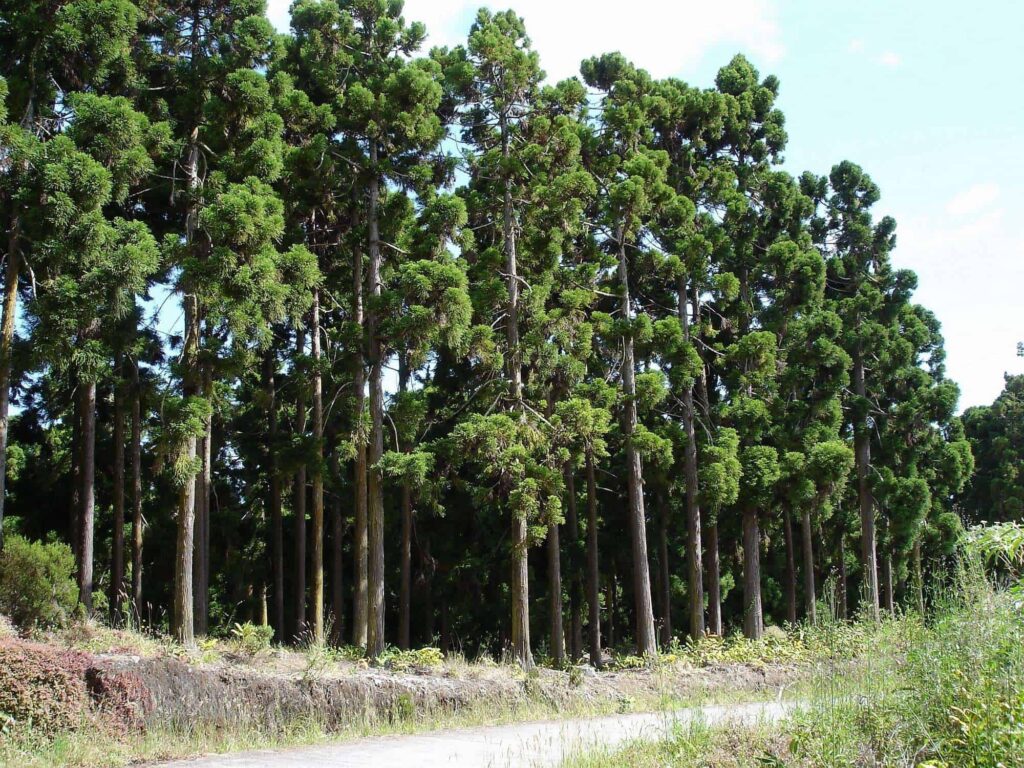
| Characteristic | Description |
| Sound Barrier Effectiveness: | Effective ●●●●○ |
| Common Name: | Sugi |
| Scientific Name: | Cryptomeria japonica |
| Family: | Cupressaceae |
| Care Level: | Low to moderate. |
Sugi, also known as Cryptomeria, is a Japanese evergreen tree that makes a good sound barrier because it grows tall and has dense foliage. The Sugi tree needs full sun to partial shade, consistently moist soil, and should be regularly watered.
Fertilize it in early spring and late summer using a balanced fertilizer on well-draining, loamy soil for planting. It’s an evergreen plant and can be propagated from seeds or semi-hardwood cuttings.
On average, it reaches a height of 50 to 70 feet, but it can grow taller under ideal conditions. The plant has a fast growth rate when provided with the right environment.
Lawson Cedar
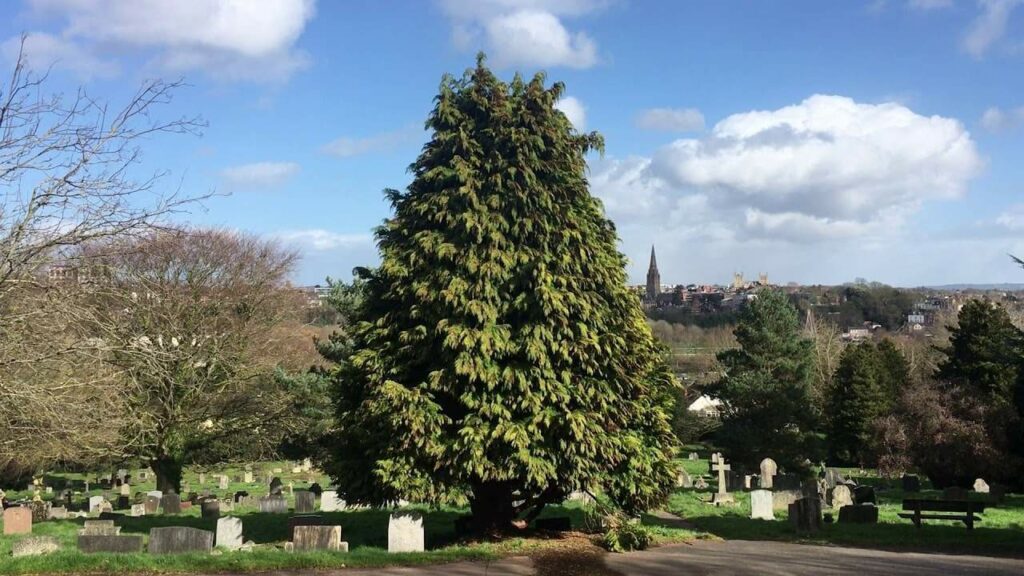
| Characteristic | Description |
| Sound Barrier Effectiveness: | Effective ●●●●○ |
| Common Name: | Lawson Cedar |
| Scientific Name: | Chamaecyparis lawsoniana |
| Family: | Cupressaceae |
| Care Level: | Moderate. |
If you’re wondering what trees make the best sound barrier, then this one could be for you. Lawson Cedar, also known as Port Orford Cedar, is an evergreen tree with aromatic wood and dense foliage that keeps the outside noise away.
Give the Lawson Cedar full sun to partial shade for its light needs and for watering, it prefers regular watering and well-draining soil. Fertilizing should be done in the spring using a balanced slow-release or organic fertilizer.
As for the soil, it thrives best in well-draining, slightly acidic to slightly alkaline soil, especially when propagating from seeds or softwood cuttings. On average, it reaches a height of 40 to 75 feet with a moderate to fast growth rate.
Thuja
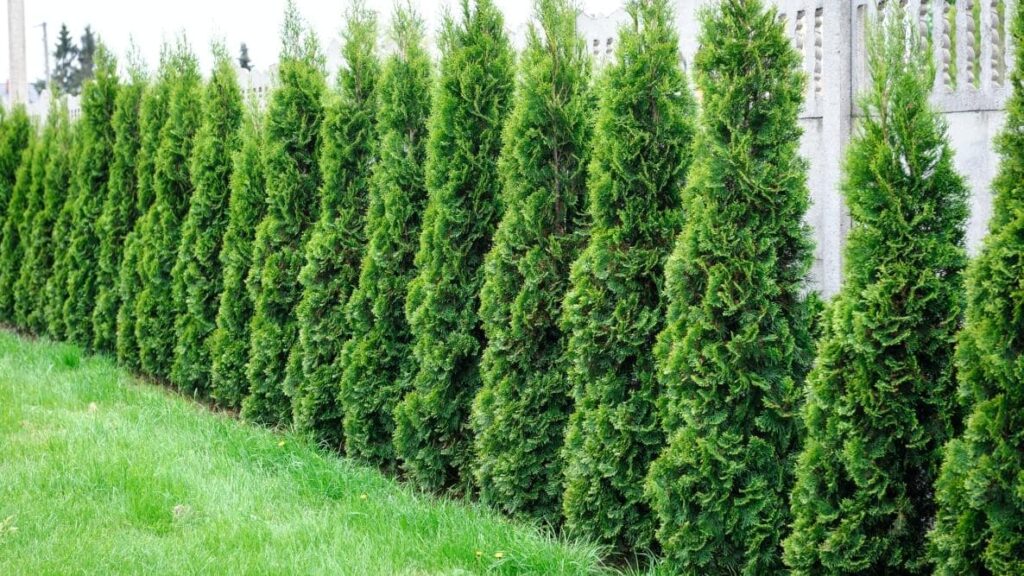
| Characteristic | Description |
| Sound Barrier Effectiveness: | Excellent ●●●●● |
| Common Name: | Arborvitae |
| Scientific Name: | Thuja spp. |
| Family: | Cupressaceae |
| Care Level: | Low to moderate. |
Thuja, also known as Arborvitae, is an evergreen tree that’s often used for privacy screens and sound barriers. Due to its dense foliage and tall growth, it reduces noise effectively and, when planted in rows, blocks noise even more.
Thuja needs full sun to partial shade for optimal growth, regular watering, and well-draining, loamy soil. Fertilize it once a year in early spring using a balanced slow-release fertilizer.
The plant is evergreen and can be propagated from seeds or semi-hardwood cuttings. Its average height varies depending on the species, generally ranging from 10 to 60 feet with a moderate to fast growth rate.
Cypress
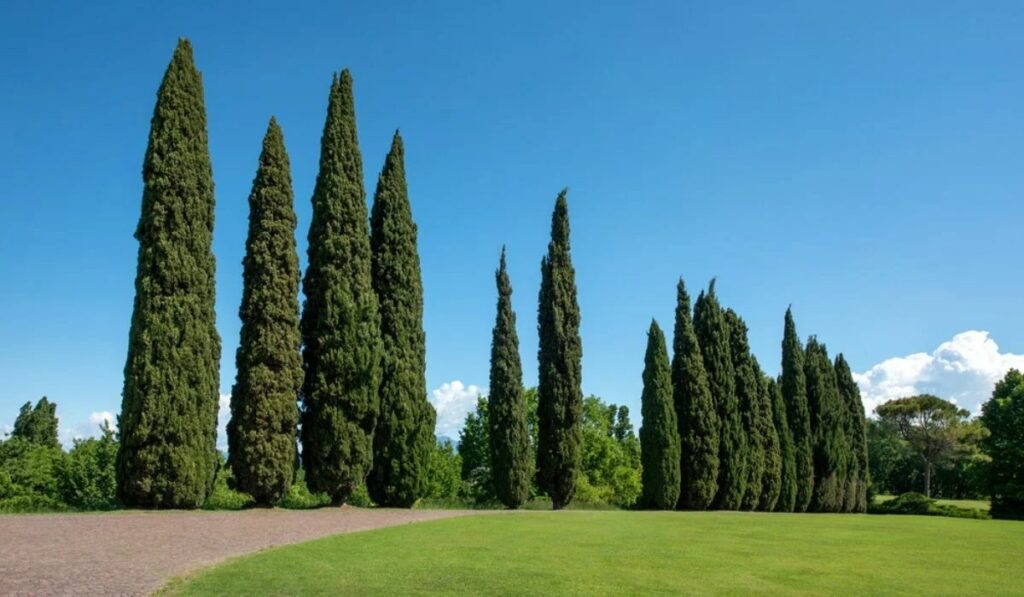
| Characteristic | Description |
| Sound Barrier Effectiveness: | Excellent ●●●●● |
| Common Name: | Cypress |
| Scientific Name: | Cupressus spp. |
| Family: | Cupressaceae |
| Care Level: | Low to moderate. |
Evergreen Cypress trees are great sound barriers due to their tall, columnar growth habit. Consider them among our top picks for fast growing sound barrier trees.
The Cypress tree requires full sun to partial shade and regular watering, but once established, it becomes drought-tolerant. Fertilize it in early spring using a balanced slow-release fertilizer, preferring well-draining soil while adapting to various soil types
It has an evergreen life cycle, and you can propagate it from seeds or softwood cuttings and its growth rate ranges from moderate to fast. The average height varies depending on the species, typically ranging between 20 to 70 feet.
Spruce
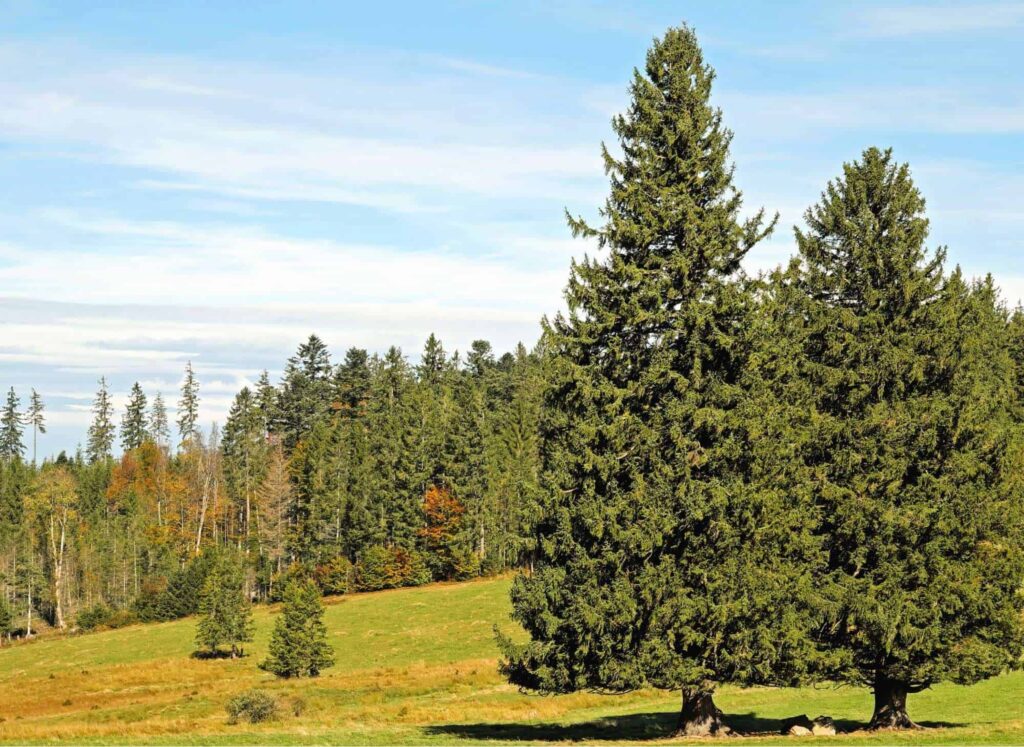
| Characteristic | Description |
| Sound Barrier Effectiveness: | Excellent ●●●●● |
| Common Name: | Spruce. |
| Scientific Name: | Picea spp. |
| Family: | Pinaceae. |
| Care Level: | Low to moderate. |
Evergreens like spruce trees are great sound barrier trees with dense foliage and a conical shape, so plant them densely for excellent sound barriers. Spruce trees grow best under full sun to partial shade, preferring regular watering and well-draining soil.
It thrives in well-draining, slightly acidic soil and remains evergreen throughout its life cycle and propagation can be done from seeds or semi-hardwood cuttings. The average height varies depending on the species and generally ranges from 20 to 200 feet.
The plant has a moderate to fast growth rate and is generally non-toxic, although some parts may cause mild gastrointestinal discomfort when ingested.





